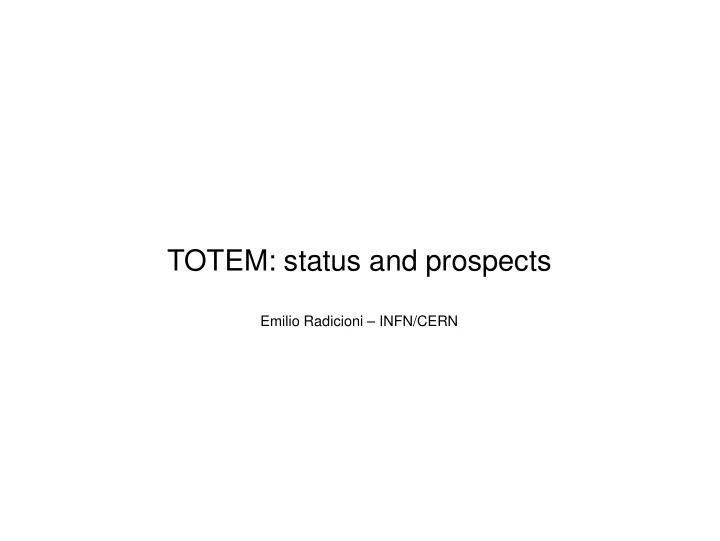

TOTEM: status and prospects Emilio Radicioni – INFN/CERN
Overall Configuration @IP5 Forward Telescopes: measure primary/secondary tracks CMS HF T1 10.5 m T2 ~ 14 m Roman Pots: measure scattered protons RP1 RP2 147 220
T1 telescope with Cathode Strip Chambers (CSCs) 3m CMS muon end-caps IP T1 3.1 < | η | < 4.7 Wire pitch: 3mm Cathode pitch: 5mm Gas gap: 10mm Total anodes: 1124 Total strips: 15936 •5 planes with measurement of 3 coordinates per plane •3 deg rotation and overlap between adjacent planes •Primary vertex reconstruction allows background rejection •Trigger with anode wires
T2 telescope (GEM chambers) 65( φ ) x 24(=1560 pads) ● Pads: ΔηΔΦ =0.06 x 0.015 π ● 2x2 mm 2 → 7x7 mm 2 ● Strips: 256 (width/pitch: 80/400 μ m) ● TOTAL strips: 256x10x2 ● TOTAL pads: 1560x10x2 ●
Castor Castor Collar Beam T2 GEM
RP system: total 122880 channels in 4 stations (+/- 220m). 4 additional stations to be installed (+/-147m)
● Planar edge-less (50 μ m) silicon sensor track beam ● Specific guard ring configuration to minimize dead edge
Status
T2 very forward GEM chambers ● Present status: commissioning and alignment ● Track reconstruction in an hostile environment, large particle density ● Severe backgrounds in the very Vertex reconstruction forw cone Precision: σ ~ 2 cm ● Beam gas and halo interactions ● Photon and hadron interactions producing showers ● Vertex pointing / impact parameter calculation important to reject re- interactions all 4 quarters installed & operational . trigger: min bias track, ≥ 5 out of 10 planes in road- coincidence.
T2 event at √ s = 7 TeV K. Österberg Soft diffraction workshop 25-26.6.2009
Roman Pots with edgeless Silicon detectors Measure elastic & diffractive protons close to the outgoing beams all 12 pots at 220 m equipped & operational Track trigger: 3 out of 5 planes in u & v projection road-coincidence
RP in retracted position Only background beam K. Österberg Soft diffraction workshop 25-26.6.2009
RP tracking in retracted position Top Too many combinations ( shower) Bottom Too many combinations (shower)
Moving RPs w.r.t. Collimators 1 RP @4.4 σ (12/2009) BLM spike 40 mm d from beam centre BLM Beam d = 4 mm (~ 4.4 σ ) RP out of collimator shadow Screenshot from the LHC Control Center
Fully operational T1 in commissioning area Cu target Beam monitor frame Strip efficiency / HV
Plans for measurements
RP system acceptance ● Machine optics determines acceptance ● Likely running scenarios in 2010/2011: ● β *=2m ● β *=90m ● Acceptance for diffractive protons and capabilities to extrapolate towards t=0 change dramatically Acceptance for RP 220m ξ/ t plane x/y plane
Elastic Scattering √ s = 7 TeV, β * = 2m trigger: RP vert,45 .and. RP vert,56 Elastically scattered proton flux [mb/mm 2 ] RP220 10 σ beam envelope At larger |t|, σ is several orders of magnitude smaller ( ≈ mHz) → dedicated long runs with vertical rate few 10 Hz (RP @10 σ beam pots at largest β * = 2m, N= 43 & N/bx = 5 10 10 ) possible luminosity
Diffractive p @ β * =2m SD protons @ RP 220 log( ξ ) RP 220 acceptance 10 σ 15 σ 15 % 1.5 % x [mm] log(|t/|GeV 2 ) 0.02 mb of tracks both in hor.-vert. Pythia SD: σ acc,sd ≈ 1.2 mb ( x2) / σ sd ≈ 13.7 mb Phojet CD: σ acc,cd ≈ 0.05 mb / σ cd ≈ 1.33 mb
Diffractive p @ β * =2m Courstesy K. Osterberg
Summary measurements @ * =2m
Studies @ β *=90m ● Access to a much larger | t | and ξ range --> ● Elastic scattering in a wider | t | range ● Total cross section at 5% ÷ 6% accuracy ● T1 to complete η coverage ● Soft diffraction in a large M range (65% of diffractive protons are detectable) ● Systematic study the event classification of interest for HECR: SD, inelasticity, rates and multiplicity
T2-only studies (5.3< η <6.5) ● May be performed at any β * ● dN charged /d η ● Search for high charged multiplicity events ● Rate very high at β *=2m ● Conditions ● Trigger: T2 plus ( ≥n track) .or. T2 minus ( ≥n track) ● Require ≤ 1 interaction/bx, i.e. ≤ 0.35/bx – At standard bunch intensity, take data at end of fill? ● Require good understanding of tracking, vertexing and primary/secondary track discrimination
Summary ● Early measurements at all β * ● Large |t| elastic (0.65 < |t| < 5 GeV 2 ) ● Large mass SD and CD ● Forward charged multiplicity (T2-only) ● (+ training for better optics) ● Later measurements with special optics, β *=90m ● Early measurements of σ tot with precision 5%÷6% ● Elastic scattering in a lower range (0.15 < |t| < 2.5 GeV 2 ) ● SD and CD in a large M range ● Classification of inelastic events
Recommend
More recommend